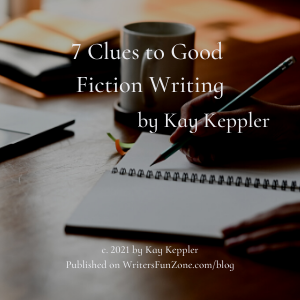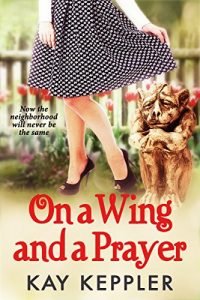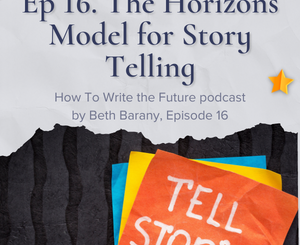7 Clues to Good Fiction Writing by Kay Keppler
 Let’s welcome back monthly columnist, editor, and novelist, Kay Keppler, as she shares with us “7 Clues to Good Fiction Writing.” Enjoy!
Let’s welcome back monthly columnist, editor, and novelist, Kay Keppler, as she shares with us “7 Clues to Good Fiction Writing.” Enjoy!
***
When I’m reading for pleasure, my favorite genre is mystery.
I like the puzzle, I tend to appreciate the characters’ quirks, and I like the justice—emotional and legal—that comes at the end when the killer is revealed.
Dana Stabenow is one of my favorite mystery writers, a best-selling author with a couple of long-running series and an Edgar to her name.
In a recent article published on WritersDigest.com, she outlined seven tips for mystery writers.
For those who are planning or in the process of writing a mystery, these suggestions are invaluable. However, they really apply to any kind of fiction.
Of course, your mileage may vary. Everyone works differently and might even approach different books differently. Try things to see what works and skip the rest.
Stabenow says:
1. Begin with the murder.
Get into the victim’s head as they die.
Make it as real and as awful as you can.
This invests the reader with sympathy for the victim no matter how horrible they were in life and lends that much more urgency to your protagonist’s quest to find the murderer.
It will make finding the killer that much more urgent for the writer as well.
No murder? No problem! Get into your characters’ heads anyway.
Whether your character dies a victim or lives to suffer another day, give your readers a reason to invest emotionally in your characters.
2. Love your creeps.
Put the villain on display and do it early in the narrative.
Get your reader invested in the character and then betray the hell out of both of them.
Every story needs an antagonist. Make yours deliciously nasty.
3. Put your protagonist at risk.
Physically, mentally, emotionally, any or all.
[One of Stabenow’s sleuths] Liam Campbell jumped out of an airplane (on purpose), was nearly flattened by a herd of walrus, and has been shot at and missed far too many times.
We won’t even go into his love life or his family damage.
Let’s face it: We’re all a hot mess. Make your heroes human so your readers can relate to them.
Pro tip: Don’t make them drunks or addicts or on the spectrum, because all of those things have been done to death. So to speak.
Besides making your heroes human, readers love to see how they solve problems and get out of scrapes. It gives everyone hope they can do likewise.
4. Make your protagonist a hero, if not in his own eyes, then in everyone else’s.
A hero is better than you and me; that’s why they are heroes and why they deserve their own novel and you and I don’t.
How?
In the end, the hero always Does the Right Thing and justice is served, if not the law.*
*If you don’t know the difference you’re in the wrong business.
Some books—even some mysteries—have ambiguous endings. Do those work? You—and your readers—will be the judge.
5. Never neglect setting.*
It’s key to everything that follows.
What does it look like, smell like, sound like, feel like?
What effect does the setting have on the characters, and why?
Once you figure out the setting, you can figure out who lives there and after that what they’re up to.
*Maps are always good, for you and for the reader.
Setting can be another “character” in your book. Use it effectively, and it shapes who your characters are and what they do.
6. Decide early on if you’re writing a series or a stand-alone.*
Don’t introduce that great character only to kill him off at the end of the first book of a 22-book (and counting) series.
Don’t ask me how I know.
*Realize that a book can turn on you at any time, and often will.
Okay, this tip is probably only for mystery writers. But if you’re writing a mystery, it’s good advice.
7. Backstory.
Every single character gets one, including the guy who shows up once to deliver the mail.
It can be as little as a sentence or as much as a subplot running through the entire narrative.
The supporting cast is what makes a great book and what gives a series long legs.
Your hero and villain drive the plot, but your secondary characters carry the themes and motifs and can supply a point or counterpoint of humor or pathos for your story. Imbuing them with rich detail only enhances the narrative.
Finally, your book needs at least one character that readers will like and can identify with or root for, because most readers won’t stick with a story populated by characters they’re not interested in. And there’s no mystery about that!
***
Want to read more articles like this one Writer’s Fun Zone? Subscribe here.
***
ABOUT THE AUTHOR
 Kay Keppler is an author Zero Gravity Outcasts, Betting on Hope, Gargoyle: Three Enchanting Romance Novellas, and editor of fiction and nonfiction –Angel’s Kiss and Outsource It!
Kay Keppler is an author Zero Gravity Outcasts, Betting on Hope, Gargoyle: Three Enchanting Romance Novellas, and editor of fiction and nonfiction –Angel’s Kiss and Outsource It!
She lives in northern California. Contact her here at Writer’s Fun Zone in the comments below, or at kaykeppler@yahoo.com to ask questions, suggest topics, or if you prefer, complain.
***
More popular articles by Kay Keppler on Writer’s Fun Zone:






